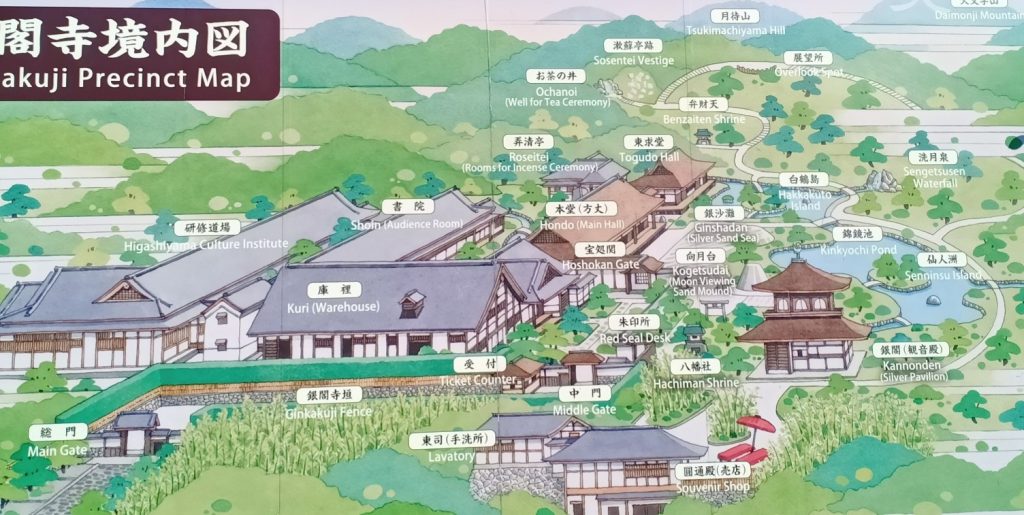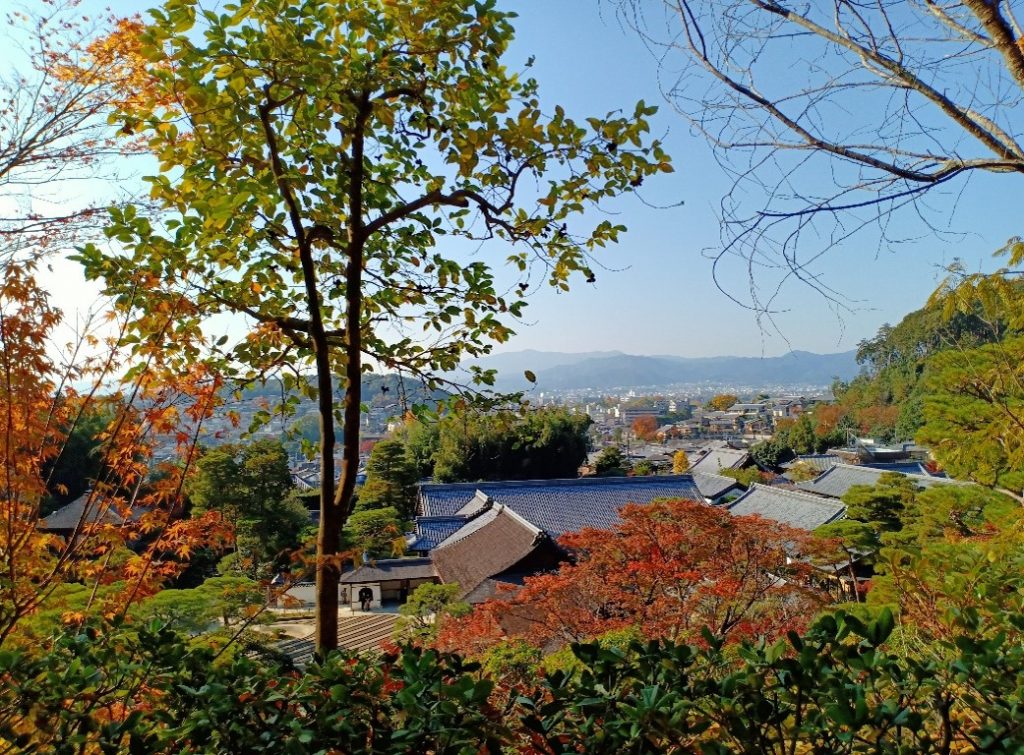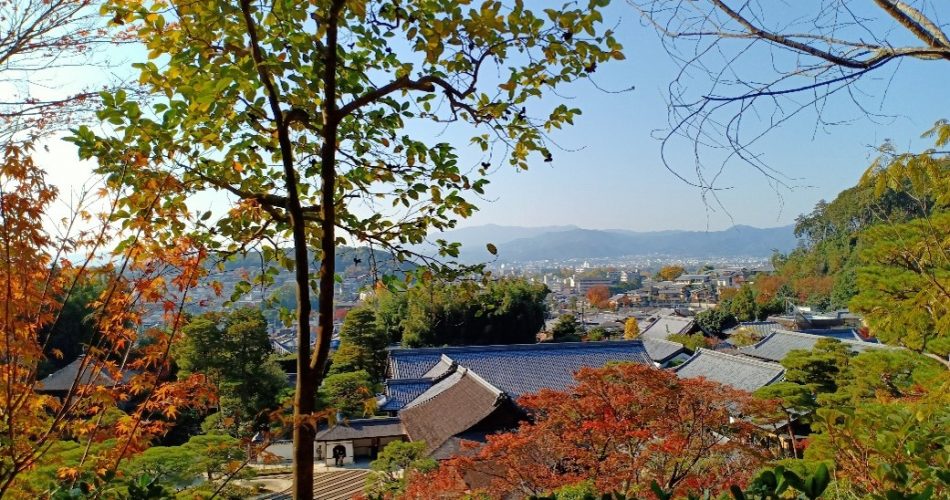Introduction
I had a chance to take part in a cultural class about Zen Buddhism and architecture. Zen styled temples are the praise of simplicity whose essence is to set yourself to ultimate freedom. Besides the colorful Gold Pavilion, which is an architectural Zen symbol of Kyoto, I am bewitched by the melancholic hue of the Silver Pavilion as well. It surprises me at the very first moment because it is not covered with silver despite its “bombastic” name. Ginkakuji, also known as the Silver Pavilion, is a masterpiece of Zen temple located in Sakyo Ward, Kyoto Prefecture on Higashiyama Mountain. It represents the unique architecture of Kyoto and was inscribed as Historic Monument of Ancient Kyoto by UNESCO in 1994. The whole complex was initially built as a retirement villa by shogun Ashikaga Yoshimasa in 1482 (Muromachi Period). Ashikaga was inspired by the design of Kinkakuji (the Golden Pavilion) which was constructed by his grandfather, shogun Ashikaga Yoshimitsu. Ginkakuji then turned into a Buddhist Temple after Yoshimasa’s death in 1490.
History
Yoshimasa decided to build Ginkakuji as an isolated palace to lead a secluded life after his retirement. The name of Ginkakuji dated back to 1482 when he planned to cover the temple with silver leaf. However, during one of the most severe wars-Onin War in Japan, the temple construction was postponed many times so that the silver coating plan had never been accomplished. Although Yoshimasa was not good at ruling the Kyoto as an administrator, he was gifted with art intelligence and this can be clearly proved by looking at Ginkakuji design. It is said that “he worked on the estate plan for several years and chose the stones used for pond himself” (Nishyuwa 2012).

The complex consists of large pond stroll garden
The building complex is a combination of two architecture styles called Shinden zukuri (palace style) and Shoin zukuri (study room style) with a pond stroll garden. Shoin zukuri design elements include distinct rooms separated by shoji screen doors, furnished with tatami mattress and decorated with “tokonoma” which is an alcove where art, flowers, ceramics and calligraphy are usually displayed (Abundance 2016). The whole complex consists of several buildings in which Ginkaku (the Pavilion) and Hondo (Main Hall) are the most outstanding. The Ginkakuji today looks quite different from that in Yoshimasa’s days due to the vast destruction over time. The pavilion and Togudo (private Buddha hall) burnt down in the war and was being under reconstruction in Edo period. The pond strolling garden, as well as the “Silver Sand Sea” and “Moon Viewing Sand Mound” are believed to be created by landscape expert Zenami in 1600s. Even though they are not Yoshimasa’s original idea, these elements blend perfectly into the landscape and are in accordance with Yoshimasa’s inspiration. In the renovation in 2008, people once had a discussion about coating Ginkaku with silver but the idea was rejected since experts aimed to retain the aesthetic concept of Ginkakuji called “Wabi-sabi” which literally means the melancholy beauty of imperfection and incomplete.

Walkthrough
Behind the main gate stands a high long L-shape bamboo fence called “Ginkakujigaki” which is built on stone wall and leads to the middle gate. After few steps, the beautiful 2-story wooden Silver pavilion appears facing the Kinkyo Pond and the garden (Figure 3). The entire replica is painted with black lacquer, augmenting the gloomy dark hues of the building. The upper floor is known as Choongaku (pavilion of roaring waves) which was built in Chinese Zen style of Sung Dynasty, decorated with Katomado (lanterned shaped windows) and attached balcony.

with a bronze phoenix at the top
The ground floor is named Shinkyuden (empty heart hall) which functioned as Yoshimasa’s study and meditation room. It is a typical example to illustrate the Shoin zukuri style with tatami mats and tokonoma (alcove). A bronze phoenix is placed on the top of the roof, as can be seen in Kinkakuji. In front of the pavilion, there stands an iconic 1.8m high “Moon viewing sand mound” (Figure 4) which is an incredibly symmetric conical shape with horizontal top surface. The mound is thought to be the representation of Mt. Fuji and reflect moonlight at night. The mound plays an important role in the illumination of Ginkakuji. Moon gazing is a traditional Japanese culture that has been appreciated for very long. Many shoin zukuri styled houses are built facing the pond so that people can enjoy the reflection of the moon on the water from the building. The pond in Ginkakuji has a total of seven stone bridges, each of which consists of two flat natural stones (Figure 5), connecting hidden islands in the garden. The garden of Ginkakuji was created using two garden techniques called “Miegakure” (hide and reveal) and “Shakkei” (borrowed scenery). With “Miegakure”, the same thing can be viewed at different angles, achieved by framing certain elements of the garden (by using gateways, for example). The garden contains two small islands (Hakkakuto and Senninsu island) and rocks half-hidden behind bushes and trees that can be discovered by changing the view angle while passengers proceed through the garden. With “Shakkei” technique, Tsukimachiyama hill and Daimonji mountain view are borrowed as the stunning background of the garden when viewed from the temple, especially in autumn when the autumn foliage reaches its peak colors.


Another remarkable garden element of Ginkakuji is Ginshadan (Silver Sand Sea) with the height of 65cm. Ginshadan is well-maintained and shaped into straight striped patterns (Figure 6) that is said to model after the West Lake in Hangzhou, China because Japanese gardens often follow the prototype of Chinese gardens. Cartwright (2019) wrote: “The sand is meticulously raked in an art form known as samon so that in moonlight its ridges appear as ripples in water”. The rock garden of Ginkakuij is a masterpiece of sophisticated arrangement technique. Every rock possesses its own meaning. A group of rocks are gathered together to imitate sceneries in Japan. For example, stones and trees in the sand sea resemble islands surrounded by the sea. Moss is also allowed to flourish luxuriantly in high humidity all over the garden, which is quite strange to western style which favors no moss growth in lawns and gardens.


The moss garden has created a unique beauty of Ginkakuji-the beauty of imperfection.
Ginshadan faces the imposing wooden Hondo (Main Hall) which was reconstructed in 2005 (Figure 8). Fusama (sliding paper panels) inside the hall, which is a figure of Shoin zukuri style, can be seen from outside. There are also paintings that was drawn by masters of Song-style painting in Edo period (Shokokuji n.d.). What I find the most attractive is the painting etched on the exterior walls of Hondo. From here, we can enjoy the splendid view of Mt. Tsukimachi.


The trip to Ginkakuji ended at the lookout point on the hill after venturing around the garden and following the winding gravel path. The panorama view of Kyoto city expanding until the horizontal line with the highlight features of Ginkakuji can be viewed from here. The isolated Ginkakuji deserves much more tourist’s attention to explore the its melancholy but metaphoric beauty.

References
Abundance, Zero. 2016. Ginkakuji (The Silver Pavilion): The mesmerising labyrinth of wabi-sabi. 06 23. Accessed 11 17, 2020. https://www.interactiongreen.com/ginkakuji/.
Cartwright, Mark. 2019. Ginkakuji. 5 14. Accessed 11 18, 2020. https://www.ancient.eu/Ginkakuji/.
Ciccone, Timothy M. 2007. Ginkaku-ji Temple. Accessed 11 17, 2020. https://www.orientalarchitecture.com/sid/203/japan/kyoto/ginkaku-ji-temple.
n.d. Garden Guide. Accessed 11 17, 2020. https://garden-guide.jp/spot.php?i=ginkakuji.
Nishyuwa. 2012. “The Silver Pavilion (Ginkaku-ji) .” Real Japanese Gardens 1.
Shokokuji. n.d. Ginkakuji. Accessed 11 18, 2020. https://www.shokoku-ji.jp/en/ginkakuji/guide/.


Comments